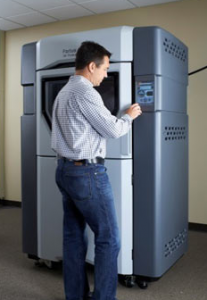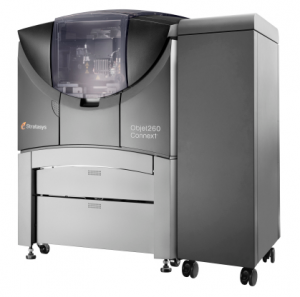 If for one second you thought that HP’s entrance into the 3D printing space would convince the leaders within the industry to roll over and die, you were certainly thinking irrationally. Although HP’s new Multi Jet Fusion technology may be the next paradigm within 3D printing, according to some, this technology could still be as far as two years off. This will provide the leaders in the space more than enough time to try and catch up with the tech giant’s ambitions.
If for one second you thought that HP’s entrance into the 3D printing space would convince the leaders within the industry to roll over and die, you were certainly thinking irrationally. Although HP’s new Multi Jet Fusion technology may be the next paradigm within 3D printing, according to some, this technology could still be as far as two years off. This will provide the leaders in the space more than enough time to try and catch up with the tech giant’s ambitions.
Stratasys, just a week after HP’s major announcement in New York City, has made quite the announcement themselves. The company, with dual headquarters in Eden Prairie, Minnesota and Rehovot, Israel, has announced 11 new high-performance 3D printers and materials, in a move which should provide investors with renewed confidence in their rapidly growing business.
The new products, which will be unveiled at EuroMold 2014, at the end of this month, include upgrades and an expansion in the company’s scope to new areas of the market.
“The global design and manufacturing market continues to push toward creating smarter products with greater efficiency. Because we believe in, and support this trend, we have announced today a range of solutions that focus on ‘democratizing design.’ Our customers, whatever their size or industry, can now access a wide spectrum of cutting-edge 3D printing capabilities and deliver competitive advantage,” said Gilad Yron, sr. vice president, Product Management, Stratasys. “We invite every designer and manufacturer at this year’s EuroMold to visit one of our three booths to see how 3D printing is shaping the way we manufacture.”
6 New Industrial PolyJet 3D Printers
Included in this expansion are six new PolyJet 3D printers targeting customers who are looking for more affordable, but smaller machines. The new printers include the compact Objet260 Connex1, Objet260 Connex2 and Objet260 Connex3, as well as the mid-size Objet350 Connex1, Objet350 Connex2 and Objet350 Connex3. If you recall, recently Stratasys expanded their Objet500 line of machines to include the Connex1 and Connex2 versions as well. In doing so they are allowing companies who may not have been able to afford the price tags of the larger printers to still benefit from their amazing PolyJet technology.
Objet30 Prime – Desktop PolyJet 3D Printer
If you want to take advantage of the incredible precision of Stratasys’ PolyJet technology, but want it in the convenience of a desktop machine, you do not have to wait any longer. The company has also announced their new Objet30 Prime printer which features 12 material options, including a rubber-like material and bio-compatible materials such as MED610. This machine will have a build envelope of 11.57 x 7.55 x 5.85 inches, with layer heights of just 16 – 36-micron depending on the material used.
Objet Eden260VS with Soluble Support Material
The Objet Eden260VS is just like the Objet Eden260V, however, it’s the first system to offer soluble support material within the PolyJet process. It will also feature automated support removal once an object is fabricated, and have the capability to build objects as large as 10.0 x 9.9 x 7.9 inches.
20% Faster FDM Printing with Fortus 450mc and Fortus 380mc
Stratasys has not forgotten about their customers who rely on FDM technology. By leveraging the technology found in their Fortus FDM-based systems, they have managed to create two more machines, the Fortus 450mc and Fortus 380mc. These machines can get the job done up to 20% quicker than their predecessors, while also making it easier for users to adjust their prints via a touchscreen interface during print. The 450mc is targeted towards companies looking to create mid-size prototypes, as well as end use parts and production aids, via some of the most advanced thermoplastics available today (such as the new Ultem material). The 380mc is more for high-performance prototyping and production tooling.
Heat and Chemical Resistant ULTEM 1010 Material
A new material called ULTEM 1010 has also been unveiled for use within FDM machines. This material is bio-compatible, meaning that it can be used to make items which are in contact with foods. Its amazing heat and chemical resistant properties also make it perfect for a variety of applications and industries including aerospace, automotive, food production tooling, and medical device manufacturing.
It’s clear that Stratasys has stepped up their game a notch or two, as they welcome the competition seemingly with open arms. It will be interesting to see what both Stratasys and 3D Systems continue to roll out in the year or two we have before any HP product hits the market. Let’s hear your thoughts on all of these new machines and materials announced, in the Stratasys Announcement forum thread on 3DPB.com.
Subscribe to Our Email Newsletter
Stay up-to-date on all the latest news from the 3D printing industry and receive information and offers from third party vendors.
You May Also Like
Further Understanding of 3D Printing Design at ADDITIV Design World
ADDITIV is back once again! This time, the virtual platform for additive manufacturing will be holding the first-ever edition of ADDITIV Design World on May 23rd from 9:00 AM –...
3D Printer Maker EVO-tech Reborn as NEVO3D — Once More With Feeling
EVO-tech was a 3D printing service and original equipment manufacturer established in 2013 and based in Schörfling am Attersee, Austria. The company produced high-quality material extrusion systems featuring linear bearings,...
3D Systems Brings 3D Printed PEEK Cranial Implant to the U.S. with FDA Clearance
For more than 10 years, 3D Systems (NYSE:DDD) has worked hand-in-hand with surgeons to plan over 150,000 patient-specific cases, and develop more than two million instruments and implants from its...
CDFAM Returns to Berlin for Second Annual Symposium
The second CDFAM Computational Design Symposium is scheduled for May 7-8, 2024, in Berlin, and will convene leading experts in computational design across all scales. Building upon the first event...



































